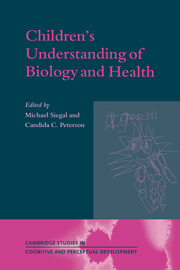Book contents
- Frontmatter
- Contents
- List of contributors
- Preface
- 1 Becoming mindful of biology and health: an introduction
- Part I Development of biological understanding
- Part II Health issues
- Part III Applications
- 9 Considering children's folkbiology in health education
- 10 Young children's understanding of the physician's role and the medical hearsay exception
- 11 Cognitive development and the competence to consent to medical and psychotherapeutic treatment
- Appendix: Hypothetical dilemma vignettes
- Author index
- Subject index
10 - Young children's understanding of the physician's role and the medical hearsay exception
Published online by Cambridge University Press: 06 July 2010
- Frontmatter
- Contents
- List of contributors
- Preface
- 1 Becoming mindful of biology and health: an introduction
- Part I Development of biological understanding
- Part II Health issues
- Part III Applications
- 9 Considering children's folkbiology in health education
- 10 Young children's understanding of the physician's role and the medical hearsay exception
- 11 Cognitive development and the competence to consent to medical and psychotherapeutic treatment
- Appendix: Hypothetical dilemma vignettes
- Author index
- Subject index
Summary
The study described in this chapter was prompted by the report of a decision of the United States Federal Eighth Circuit Court of Appeals in St. Louis (Woo, 1992). In this decision, a child molestation conviction was overturned because the appellate court determined that the presiding trial judge had erred in allowing a 3-year-old child's hearsay statements to a physician to be admitted as testimony under the medical diagnosis and treatment exception. The Federal Court of Appeals ruled that the exception does not apply when the patient is too young to understand the importance of telling the truth to the physician.
When children, especially young children, are excluded from giving testimony, the physician's report of the child's statement given during a physical examination can be of great importance. The child's statements to the physician are known as hearsay, which is a statement made out of court and later used in court to “establish the truth of what was said earlier” (Myers, 1986). While the hearsay rule exists in all English-speaking countries, different countries have different exceptions to the hearsay rule. In several countries, hearsay is more liberally admissible in civil cases (e.g., England, Scotland). In the United States, there has long been a hearsay exception for hearsay statements to health care providers. This exception is based on the premise that patients have an incentive to be truthful with a health care professional, thus rendering the hearsay reliable.
- Type
- Chapter
- Information
- Children's Understanding of Biology and Health , pp. 235 - 256Publisher: Cambridge University PressPrint publication year: 1999
- 4
- Cited by



